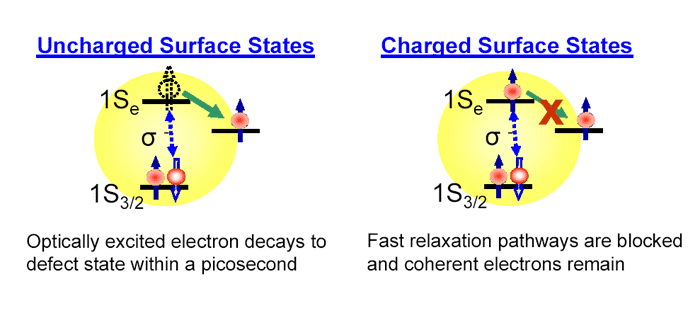Chemically synthesized semiconductor quantum dots are promising structures because of their ease of manufacture and highly size-tunable physical properties. To date, colloidal quantum dots have been used in a wide variety of applications including lasers, light-emitting devices, and fluorescent labels. Experiments have also been able to optically excite spin-polarized carriers in such colloidal nanocrystals, leading to measurement of spin dynamics in highly three-dimensionally confined quantum structures. Chemical linking of the quantum dots has led to coherent transport of electron spins between different nanocrystals. With the ability to inject spin information and transfer it between quantum dots, the behavior of these spins in different charge environments becomes important.
Recent experiments have succeeded in controlling the charging of the lowest electron state in colloidal quantum dots in an electrochemical cell. This charging can be detected by a bleaching of absorptive transitions when the lowest quantum state is filled with electrons. Since CdSe quantum dots absorb in the visible range of the spectrum, a film of nanocrystals exhibits a visible color change when bleached in a charged electrochemical cell.

We use time-resolved Faraday rotation measurements to investigate the spin room temperature dynamics of colloidal CdSe quantum dots in both the charged and uncharged state. The evolution of the spin dynamics reflects the filling of surface states and the voltage-controlled electron occupation of the quantum dot states. Typical time-scans for different electrochemical charging voltages are shown below. Fourier transforms show that the two precession frequencies typically observed in uncharged CdSe quantum dots become a single spin precession frequency upon charging. It has been suggested that the higher frequency component is due to coherent precession of an exciton in the quantum dot. Since extra electrons in the quantum suppress detection of excitons, this frequency component is quenched when the dots are electrochemically charged.

The increase in spin precession amplitude upon charging is likely due to the filling of surface states on the nanocrystal. These localized states have been shown to trap up to 50% of optically injected carriers within a picosecond. When these states are filled by electrochemically injected charges, the charge relaxation pathway is blocked and more charges remain in the conduction band, leading to stronger spin precession signal.
Fits to the Faraday rotation data indicate that the spin lifetime of the optically injected electrons increases, but direct measurement of this effect is precluded by the high degree of inhomogeneous dephasing due to ensemble measurement of quantum dots with random crystallographic orientations.

To learn more about these studies, please refer to "Spin dynamics in electrochemically charged CdSe quantum dots", N. P. Stern, M. Poggio, M. H. Bartl, E. L. Hu, G. D. Stucky, and D. D. Awschalom Phys. Rev. B 72 161303(R) (2005).